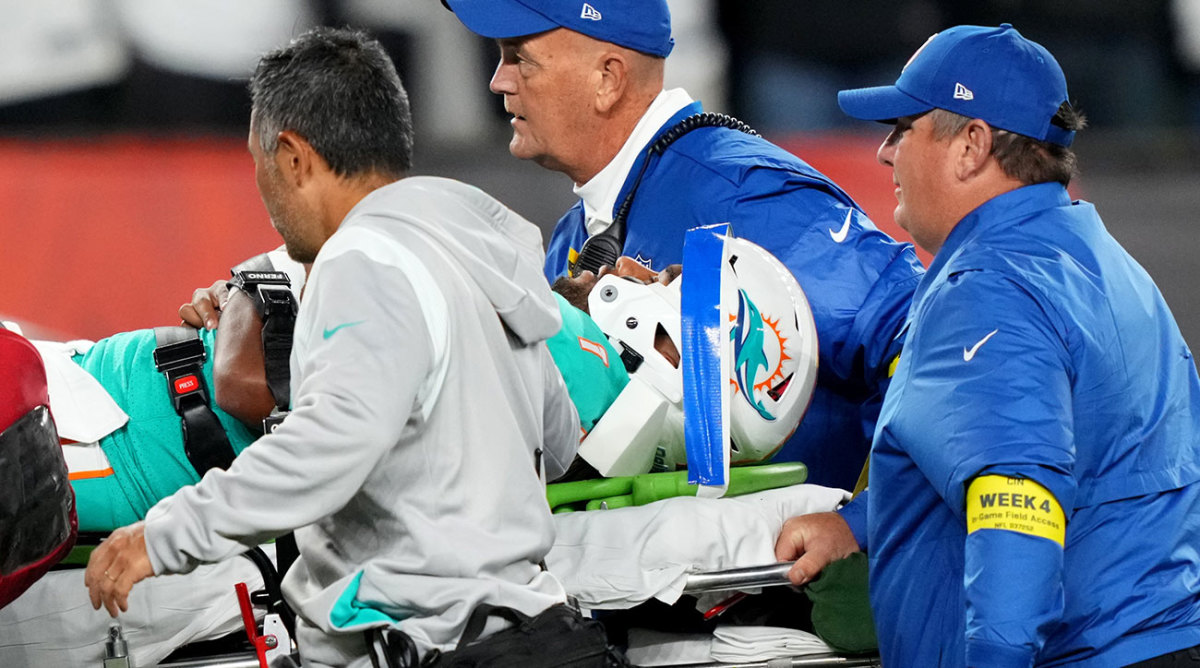Tua Tagovailoa’s Injury Makes It Complicated to Love the NFL
On Thursday night, the football-watching public saw a human being get thrown to the ground at a speed so great it caused his neck to jerk backward like a broken Pez dispenser.
Upon impact, the person could be seen slowly rolling over onto his back and looking at his fingers, which were splayed in myriad directions. The person was taken away on a stretcher and rushed to a nearby hospital.
Four days earlier that same person was shoved following a jumping movement while throwing a ball and slamming his head against the ground. He was barely able to return to his feet, which meant that the impact of the shove occurred when he was in a vulnerable position, unable to brace his body for a rapid free-fall to the ground. Upon standing up, he made it eight steps before stumbling and falling to one knee. He told everyone he had a back injury and was cleared to move on with his day.

After the injury Thursday, no one in a position of authority communicating with the public on the live broadcast mentioned what had happened Sunday for more than an hour. No one mentioned that the person’s union was investigating the processes with which the injury he sustained Sunday was handled. About 45 minutes after the person had arrived at the hospital Thursday, someone, on live television, mentioned how the person couldn’t quite throw a football as far as he needed to once earlier in the day. About 48 minutes after the person had arrived at the hospital, someone on live television, taking in the atmosphere that had just produced haunting trauma said something to the effect of: Don’t you just love this?
When you replace “football player” or “Dolphins quarterback” or “Tua Tagovailoa” with “human being” or “person,” does it do anything for you? When we take out the underlying comfort words we tell ourselves—that these players signed up for this and that injuries are part of professional football—does it seem messed up?
If you had a child who fell off playground equipment and onto their head, and did the same thing four days later, would you be unsettled? Would you tell a medical professional, perhaps frantically, that this had just happened a few days earlier and that you’re pretty worried about it? If your coworker twice fell from a ladder inside a supply warehouse, would you, an hour later, say, “Earlier in the day, that guy put some files in the wrong place, but we hope he’s O.K.”?
Five years ago, we watched Steelers linebacker Ryan Shazier on Thursday Night Football make a tackle that ended his career. It took him about a year to start walking even a few steps from the draft’s backstage to a lectern. Back then, we wondered whether we’d ever get better at handling these moments.
It seems the answer is no, at least from a psychological standpoint, and this is not really a societal criticism. It’s simply an acknowledgment that, despite a widespread and immediate reaction on social media before Tagovailoa had even been strapped to his stretcher, we’re largely still slipping into autopilot after each messed-up thing goes down. It was quickly onto Teddy Bridgewater and blitz pickups and missed extra points. The NFL is typically our escape from the scary moments on the playground or the office. From the worries about our own children and friends. About ourselves. And so it seems many of us can never quite grasp the seriousness of something horrific we’re seeing on television during a live football game happening to another person.
The NFL, the Dolphins and everyone else in the big chairs calling shots are a different story, and God help them all if there were some irregularities in the process that led Tagovailoa to the field Thursday, and if the trauma he sustained Sunday had any impact on the terrifying contortions we saw his body make a few days later. It’s not for us to speculate about.
What we can wonder, though, is the same thing we asked ourselves a half decade ago: What is our responsibility in this? How can we collectively react in a way that demands the league and the broadcast and the teams and the teammates and the analysts who, once upon a time, seemed so critical of short-rest football, reflect that primal discomfort we feel in our gut when something like this happens? The league has made progress in recent years, pulling high-profile players from high-profile moments more regularly, thanks largely to public outcry. But we still snap right back into game action, as if we are somehow programmed to place the utmost importance on the spectacle over the human. For anyone else watching, did the game seem like a blur, or was there time to dial into your fantasy football implications?
Amazon Prime Video’s postgame show actually contained a sober discussion on the reality of the situation that presented factual information. Former players such as Ryan Fitzpatrick and Richard Sherman speculated on why Tagovailoa may have been allowed back on the field Sunday. Andrew Whitworth shared a story about how he felt pressured to go back into a game with a diagnosed concussion. How do we get to the point where we can do that right after a player goes down, and not experience that gap in time when we’re willfully ignoring trauma?
How can we maintain a legitimate level of concern and horror that doesn’t dissipate in the moments between these awful incidents? Is there a way for us to stay in love with this game and remain, at our core, people who care about other people?
More NFL coverage:
• Next Man Up: Top Coaching Candidates for 2023
• Jalen Hurts Determined to Dismiss His Doubters
• The Jaguars Could Be for Real
• MMQB Week 4 Staff Picks
